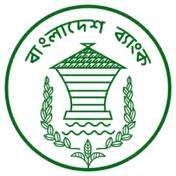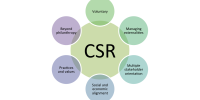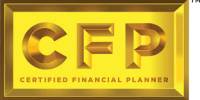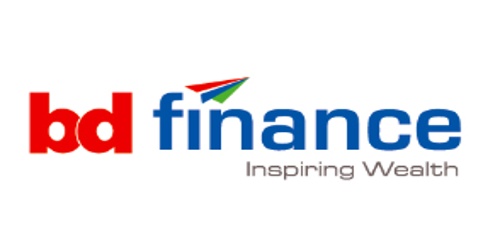Introduction- Bangladesh Bank has been entrusted with all the traditional central banking functions including the sole responsibilities of issuing currency, keeping the reserves, formulating and managing the monetary policy and regulating the credit system of Bangladesh with a view to stabilizing domestic and external monetary value and promoting and maintaining a high level of production, employment and real income in the country. The bank acts as the banker to the government and accepts government deposits, cheques and drafts, and undertakes collection of cheques and drafts drawn on other banks. The government deposits all its cash balances with the Bangladesh Bank free of interest. The bank transfers government funds from one place to another as requested by the government and its agencies.
The purchase, sale and rediscount of bill of exchange and promissory notes drawn on and payable in Bangladesh are also included in the activity of the bank. The bank acts as the lender of last resort for the government as well as for the country’s scheduled banks.
Bangladesh Bank exercises its wide range of power in credit control through different types of traditional and non-traditional methods. In addition to bank rate and open market operations, it uses a number of other weapons. It can vary the minimum reserve requirements of scheduled banks whenever circumstance so warrant. Being responsible for maintaining external value of Bangladesh currency, the bank also handles the exchange control. It ensures that all foreign exchange inflows are accounted for, and surrendered to the authorized dealers. It allocates and rations foreign exchange in line with the set priorities. Bangladesh Bank is empowered to manage the country’s international reserves, which represent aggregate of its holding of gold, foreign exchange, SDR and reserve position in the IMF. The bank also acts as the representative of the government in different international agencies and other forums such as World Bank, IMF, Asian Clearing Union, ADB, etc.
What is mean by OMO
Definition of – OMO:
The buying and selling of government securities in the open market in order to expand or contract the amount of money in the banking system. Purchases inject money into the banking system and stimulate growth while sales of securities do the opposite.
Explains – OMO:
Open market operations are the principal tools of monetary policy. (The discount rate and reserve requirements are also used.) The U.S. Federal Reserve’s goal in using this technique is to adjust the federal funds rate–the rate at which banks borrow reserves from each other.
Classification of OMO defensive
Asset: Any item of economic value owned by an individual or corporation, especially that which could be converted to cash. Examples are cash, securities, accounts receivable, inventory, office equipment, real estate, a car, and other property. On a balance sheet, assets are equal to the sum of liabilities, common stock, preferred stock, and retained earnings.
At first we classify assets into tangible assets and intangible assets. Definition and explanation are given below:
Tangible asset: Assets having a physical existence, such as cash, equipment, and real estate; accounts receivable are also usually considered tangible assets for accounting purposes. In short, it is the opposite of intangible asset.
Intangible asset: Something of value that cannot be physically touched, such as a brand, franchise, trademark, or patent. In short, it is the opposite of tangible asset. All the tangible assets are described below with examples.
Trademark (™): A distinctive name, symbol, motto, or design that legally identifies a company or its products and services, and sometimes prevents others from using identical or similar marks. Distinctive design, graphics, logo, symbols, words, or any combination thereof that uniquely identifies a firm and/or its goods or services, guarantees the item’s genuineness, and gives it owner the legal rights to prevent the trademark’s unauthorized use. A trademark must be (1) distinctive instead of descriptive, (2) affixed to the item sold, and (3) registered with the appropriate authority to obtain legal ownership and protection rights.
Copyrights (©): It is a legal monopoly that protects published or unpublished original work (for the duration of its author’s life plus 50 years) from unauthorized duplication without due credit and compensation. Copyright covers not only books but also advertisements, articles, graphic designs, labels, letters (including emails), lyrics, maps, musical compositions, product designs, etc. According to the major international intellectual-property protection treaties(Berne Convention, Universal Copyright Convention, and WIPO Copyright Treaty) five rights are associated with a copyright: the right to: (1) Reproduce the work in any form, language, or medium. (2) Adapt or derive more works from it. (3) Make and distribute its copies. (4) Perform it in public. (5) Display or exhibit it in public. To acquire a valid copyright, a work must have originality and some modicum of creativity
Patents: Limited legal monopoly granted to an individual or firm to make, use, and sell its invention, and to exclude others from doing so. An invention is patentable if it is novel, useful, and non-obvious. To receive a patent, a patent application must disclose all details of the invention so that others can use it to further advance the technology with new inventions. Patentable items fall under four classes (1) Machine: apparatus or device with interrelated parts that work together to perform the invention’s designed or intended functions, (2) Manufacture: all manufactured or fabricated items, (3) Process: chemical, mechanical, electrical or other process that produces a chemical or physical change in the condition or character of an item, and (4) Composition of matter: chemical compounds or mixtures having properties different from their constituent ingredients.
Goodwill: It is an intangible asset which provides a competitive advantage, such as a strong brand, reputation, or high employee morale. In an acquisition, goodwill appears on the balance sheet of the acquirer in the amount by which the purchase price exceeds the net tangible assets of the acquired company. In other words, it is assumed value of the attractive force that generates sales revenue in a business, and adds value to its assets. Goodwill is an intangible but saleable asset, almost indestructible except by indiscretion. It is built painstakingly over the years generally with (1) heavy and continuous expenditure in promotion, (2) creation and maintenance of durable customer and supplier relationships, (3) high quality of goods and services, and (4) high quality and conduct of management and employees. Goodwill includes the worth of corporate identity, and is enhanced by corporate image and a proper location. Its value is not recognized in account books but is realized when the business is sold, and is reflected in the firm’s selling price by the amount in excess over the firm’s net. In well established firms, goodwill may be worth many times the worth of its physical assets. GAAP require the firm’s purchaser to write off (amortize) the amount paid as goodwill over a period (usually 10 to 30 years) for financial reporting purposes.
Brand: It is an identifying symbol, words, or mark that distinguishes a product or company from its competitors. Usually brands are registered (trademarked) with a regulatory authority and so cannot be used freely by other parties. For many products and companies, branding is an essential part of marketing. Unique design, sign, symbol, words, or a combination of these, employed in creating an image that identifies a product and differentiates it from its competitors. Over time, this image becomes associated with a level of credibility, quality, and satisfaction in the consumer’s mind (see positioning). Thus brands help harried consumers in crowded and complex marketplace, by standing for certain benefits and value. Legal name for a brand is trademark and, when it identifies or represents a firm, it is called a brand. Royalty Compensation, consideration, or fee paid for a license or privilege to use an intellectual property (brand, copyright, patent, process) or a natural resource (fishing, hunting, mining), computed usually as a percentage of revenue or profit realized from the use.
Franchise: A form of business organization in which a firm which already has a successful product or service (the franchisor) enters into a continuing contractual relationship with other businesses (franchisees) operating under the franchisor’s trade name and usually with the franchisor’s guidance, in exchange for a fee.
Instruments used in OMO
Central banks implement a country’s chosen monetary policy. At the most basic level, this involves establishing what form of currency the country may have, whether a fiat currency, gold-backed currency (disallowed for countries with membership of the International Monetary Fund), currency board or a currency union. When a country has its own national currency, this involves the issue of some form of standardized currency, which is essentially a form of promissory note: a promise to exchange the note for “money” under certain circumstances. Historically, this was often a promise to exchange the money for precious metals in some fixed amount. Now, when many currencies are fiat money, the “promise to pay” consists of the promise to accept that currency to pay for taxes.
A central bank may use another country’s currency either directly (in a currency union), or indirectly (a currency board). In the latter case, exemplified by Bulgaria, Hong Kong and Latvia, the local currency is backed at a fixed rate by the central bank’s holdings of a foreign currency.
In countries with fiat money, the expression “monetary policy” may refer more narrowly to the interest-rate targets and other active measures undertaken by the monetary authority. A central bank, reserve bank, or monetary authority is an institution that manages a nation’s currency, money supply, and interest rates. Central banks also usually oversee the commercial banking system of their respective countries. In contrast to a commercial bank, a central bank possesses a monopoly on increasing the nation’s monetary base, and usually also prints the national currency, which usually serves as the nation’s legal tender.[1][2] Examples include the European Central Bank (ECB), the Federal Reserve of the United States, and the People’s Bank of China.
Functions of a central bank may include:
- Implementing monetary policies.
- determining Interest rates
- controlling the nation’s entire money supply
- the Government’s banker and the bankers’ bank (“lender of last resort”)
- managing the country’s foreign exchange and gold reserves and the Government’s stock register
- regulating and supervising the banking industry
- setting the official interest rate – used to manage both inflation and the country’s exchange rate – and ensuring that this rate takes effect via a variety of policy mechanisms
What is the central bank Objective is using OMO?
An open market operation (also known as OMO) is an activity by a central bank to buy or sell government bonds on the open market. A central bank uses them as the primary means of implementing monetary policy. The usual aim of open market operations is to control the short term interest rate and the supply of base money in an economy, and thus indirectly control the total money supply. This involves meeting the demand of base money at the target interest rate by buying and selling government securities, or other financial instruments. Monetary targets, such as inflation, interest rates, or exchange rates, are used to guide this implementation.[1][2]
Since most money now exists in the form of electronic records rather than in the form of paper, open market operations are conducted simply by electronically increasing or decreasing (crediting or debiting) the amount of base money that a bank has in its reserve account at the central bank. Thus, the process does not literally require new currency. However, this will increase the central bank’s requirement to print currency when the member bank demands banknotes, in exchange for a decrease in its electronic balance.
When there is an increased demand for base money, the central bank must act if it wishes to maintain the short-term interest rate. It does this by increasing the supply of base money. The central bank goes to the open market to buy a financial asset, such as government bonds, foreign currency, gold, or seemingly nonvolatile (until the 2008 financial fallout) MBS’s [3] (Mortgage Backed Securities). To pay for these assets, bank reserves in the form of new base money (for example newly printed cash) are transferred to the seller’s bank and the seller’s account is credited. Thus, the total amount of base money in the economy is increased. Conversely, if the central bank sells these assets in the open market, the amount of base money held by the buyer’s bank is decreased, effectively destroying base money.
Methodology used by Bangladesh Bank
In 1989, the government adopted a comprehensive Financial Sector Reform Programme (FSRP), following which the country’s monetary policy assumed a new orientation towards promotion of market economy in a competitive environment. Bangladesh Bank started moving away from direct quantitative monetary control to indirect methods of monetary management since the beginning of 1990. Although, the fixation of target continued to remain as the central piece of exercise, the way to achieve it had been changed. Credit ceilings on individual banks and direct controls of interest rates were withdrawn. At present, the money supply is regulated through indirect manipulation of reserve money instead of credit ceiling. Major instruments of monetary control available with Bangladesh Bank are the bank rate, open market operations, rediscount policy, and statutory reserve requirement.
Bank rate Until 1990, the use of this instrument as the lending rate of the central bank for borrowings of the commercial banks to meet their temporary needs was virtually non-existent in Bangladesh. The rate was changed in a few occasions only to align it with the refixation of the rates of deposits and advances. Moreover, the existence of refinance facilities at rates lower than the bank rate substantially eroded its significance. However, since 1990, the instrument has been put in use to change the cost of borrowings for banks and thereby to affect the market rate of interest. Bank rate was gradually lowered from 9.75% in January 1990 to 5% in March 1994. It was raised to 5.75% from 10 September 1995 and further, to 7.5% and 8% from 19 May 1997 and 20 November 1997 respectively. The rate was lowered to 7% from 29 August 1999.
Open market operations (OMO) These involve the sale or purchase of securities by the central bank to withdraw liquid funds from the banking system or inject the same into that system. OMO allows flexibility in terms of both the amount and timing of intervention, which did not exist in Bangladesh before 1990. Bangladesh Bank introduced a 91-day Bangladesh Bank Bill, a market-based tool for monetary intervention, in December 1990.
Rediscount policy After the introduction of FSRP, the refinance facility was replaced by rediscount facility at bank rate to eliminate discrimination in access to central bank funds. Refinance facility is now available for agricultural credit provided by bangladesh krishi bank and for projects of Bangladesh Rural Development Board financed by sonali bank. Banks are advised to extend credit considering banker-customer relationship.
Statutory reserve requirement Cash reserve requirement (CRR) of the deposit money banks has a significant potential to regulate money supply through affecting money multiplier, while statutory liquidity requirement (SLR) is generally used to affect the lending capability of the bank. Bangladesh Bank used these two instruments very infrequently before 1990 and very often after 1990. The CRR and SLR were 8% and 23% respectively on 25 April 1991 and were reduced to 7% and 22% respectively on 5 December 1991.
Repo with Bangladesh Bank
Auction date | Tenor | Bids received | Bids accepted | ||||
Total bids | Total amount | Int. rate(%) | Total bids | Amount | Cut-off rate(%) | ||
19/12/2011 | 01 day | 4 | 13590.65 | 7.2500 | Bid not accepted. | ||
Total | 4 | 13590.65 | 0 | 0 | |||
18/12/2011 | 01 day | 4 | 13523.66 | 7.2500 | Bid not accepted. | ||
Total | 4 | 13523.66 | 0 | 0 | |||
Reverse Repo with Bangladesh Bank
Auction date | Tenor | Bids received | Bids accepted | ||||
Total bids | Amount | Range of rate(%) | Total bids | Amount | Int. rate(%) | ||
05/01/2012 | 01 day | 1 | 180 | 5.2500 | 1 | 180 | 5.2500 |
Total | 1 | 180 | 1 | 180 | |||
04/01/2011 | 01 day | 1 | 250 | 5.2500 | 1 | 250 | 5.2500 |
Total | 1 | 250 | 1 | 250 | |||
Inter-Bank Repo
Auction date | Volume | Repo Tenor | Interest rates | ||
No. of transactions | Total amount | Range of tenor in days | Int rate (%) | Weighted average rate (%) | |
| 08/05/2012 | 17 | 2219.1700 | 01-07 | 14.00-21.00 | 14.9200 |
| 07/05/2012 | 20 | 2455.0000 | 01-07 | 14.00-17.00 | 14.7600 |
What is Repo?
Definition of Repo:
Repurchase agreement where a seller of a security agrees to buy it back from a buyer (investor) at a higher price on a specified date. These agreements are in effect loans (or short term swaps) between investors to sellers (the difference between the buying and selling prices being the investors’ earnings), and are used usually for raising short term finance by banks and corporations. Repos are used also by the central banks as instruments of monetary policy. To temporarily expand the money supply, a central bank decreases the discount rate (called repo rate) at which it buys back government securities from the commercial banks, to contract or maintain the money supply it increases the repo rate.
What is reverse Repo
Definition of reverse Repo:
A purchase of securities with an agreement to resell them at a higher price at a specific future date. This is essentially just a loan of the security at a specific rate. Also called reverse repurchase agreement.
How Bangladesh use these machinery to influence the reason of Commercial bank
The banking sector in Bangladesh comprises four types of banks, including nationalized Commercial banks (NCBs), government-owned specialized banks (DFIs), private Commercial banks (PCBs) and foreign commercial banks (FCBs). The Bangladesh Banking sector is dominated by NCBs in terms of asset value. However, since 2003 Market share of NCBs on the asset side declined substantially while that of PCBs Increased remarkably. Particularly, NCBs share declined to 41.7 percent of the total assets as against 45.6 percent in 2002 while PCBs share rose to 40.8 percent in 2003 as against 36.2 percent in 2002. Foreign commercial banks held 7.3 percent of the industry assets in 2003, showing a slight increase by 0.5 percentage point over the previous year. The NCBs’ dominance on the deposit side also was on a decline trend because of the rapid increase deposit from other banks. For example, despite the total deposits NCBs rose by 11.4 percent while their share in the deposit market decreased from 50.3 percent in 2002 to 46.0 percent in 2003. In contrast, PCBs’ deposits in 2003 accounted for 41.1 percent of the total industry deposit from 36.8 percent in the same period (NBB, 2003; 2004). In general, the performance of the banking sector in Bangladesh improved constantly with the passage of time. Table 1 shows the ratio of net non-performing loan to total loan for the period of 1997-2003. Ironically, government-related banks, with large asset share and an extensive network, always have the highest rate of non-performing loans. One possible reason is that government banks, such as NCBs have to allocated credit through 3 directed lending programs to certain economic sectors dictated by the government (NBB, 2001). In contrast, FCBs, despite their modest share in total industry’s asset, always maintained the lowest rate of non-performing loans amongst commercial banks in Bangladesh (Table 1). Perhaps, international experiences technology and advantage help FCBs outperformed their domestic counterparts in this category.
Recommendation for important of the methodology of OMO
Step 1: Identifying the Evidence
To ensure that DynaMed provides the best available evidence, an extensive set of current literature is monitored daily. Systematic Literature Surveillance is conducted using many journals, journal review services, systematic review collections, guideline collections and other sources considered relevant to a point-of-care clinical reference. For a comprehensive list of sources, see DynaMed Content Sources. These sources are derived from systematic evaluation of which sources and search strategies provide the greatest yield for identifying the most valid, relevant evidence (meeting criteria for step 2) included in DynaMed.
Step 2: Selecting the Best Available Evidence
Each article is assessed for clinical relevance and each relevant article is further assessed for validity relative to existing DynaMed content. The most valid articles are summarized, the summaries are integrated with DynaMed content, and overview statements and outline structure are updated based on the overall evidence synthesis. Article selection is completed by editors with clinical expertise and training in scientific analysis.
Step 3: Critical Appraisal
Abstracts in research publications often do not accurately reflect the methodological quality and results found in full-text articles. Article summaries in other publications often do not accurately reflect the methodological quality and results found in full-text articles.
Step 4: Objectively Reporting the Evidence
When reporting the evidence, DynaMed Editors consider all of the following questions:
- Were all relevant outcomes reported in the original article?
- What are the most relevant outcomes to report in the DynaMed topic?
- For relevant outcomes, what is the magnitude of effect? This may be represented by absolute rates and number needed to treat (NNT) or harm (NNH) abbreviations, or by absolute differences in continuous variables (e.g., mean decrease in 1.3 points on 0-10 visual analogy pain scale).
- Were the findings clinically significant?
- In the case of no statistically significant differences, were the findings robust enough to rule out clinically significant difference?
- Are there any methodological limitations sufficient to alter reliability of clinical conclusions?
Step 5: Synthesizing Multiple Evidence Reports
Evidence-based summarization of articles is necessary, but insufficient for a point-of-care reference. Understanding the best current evidence requires synthesizing multiple evidence reports.
Step 6: Basing Conclusions on the Evidence
Deriving overall conclusions and recommendations from the evidence synthesis is required for a comprehensive point-of-care reference. In DynaMed, multiple evidence reports of similar quality are organized such that the overall conclusions quickly provide a synthesis of the best available evidence.
Editors confirm that overviews are clinically useful and accurately match supporting data.
Step 7: Updating Daily
The final step in DynaMed’s evidence-based methodology is changing conclusions when new evidence alters the best available evidence. This step is crucial because new evidence is published every day. Having new evidence summaries handled separately from reviewed content in a manner requiring the clinician to search in two locations to synthesize the entire story would make finding the best available evidence more difficult.
As soon as new evidence is evaluated using the 6 steps governing systematic processing, it is added to the appropriate DynaMed topic(s) in context. This process allows immediate and comprehensive access to the best available evidence as it occurs.
Conclusion
Bangladesh Bank the central bank and monetary authority of the country. It came into existence under the Bangladesh Bank Order 1972 (Presidential Order No. 127 of 1972) which took effect on 16 December 1971. Through this order, the entire operation of the former State Bank of Pakistan in the eastern wing was transferred to Bangladesh Bank.
The powers and functions of Bangladesh Bank are governed by various laws and acts including the Banker’s Books Evidence Act 1891, Insolvency Act 1920, Banking Companies Ordinance 1962, Bangladesh Bank Order 1972, Foreign Exchange (Regulation) Act 1986, Money Loan Court Act 1990, Banking Companies Act 1991, Financial Institutions Act 1993 and Rules 1994, Companies Act 1994 and Bankruptcy Act 1997. [S M Mahfuzur Rahman]
Bangladesh Bank took measures to monitor credit and monetary expansion keeping in view the price situation and international reserves position. Efforts were made to achieve the targeted growth of domestic credit and thereby, the money supply, through imposing ceilings on credit to the government, public, and private sectors. The major policy instruments available to Bangladesh Bank were to set credit ceiling on the banks and provide liberal refinance facility at concessional rate for priority lending. According to the national economic policy, the banks were to provide the desired volume of credit at an administered and low rate of interest. In that situation, Bangladesh Bank practically did not have any effective instrument for making adjustments in the growth of money supply or for transmitting market signals into changes in money supply. The monetary policy therefore, could not function in its true sense. As a result the banking system could not play its role as an effective financial intermediary.
















